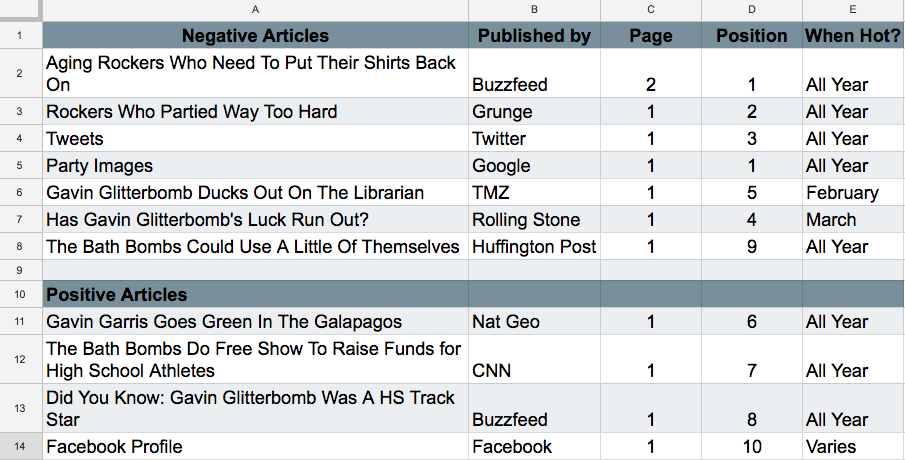Building and Executing a Reputation Management Strategy

When it comes to reputation management, what’s the best strategy? This month we’re following the story of Gavin (Garris) Glitterbomb, 80’s glam rocker turned wannabe attorney. Last week Gavin is struggling to get into law school because any time an admissions person or alumnus searches him the results are less than flattering. His friend, John, is helping him learn about and manage his online reputation. Let’s take a look at how they build and execute the reputation management plan.
First Comes Data
Before a reputation can be managed, one has to understand the information that is out there. Both good and bad. That’s because data is the heart of every good reverse SEO plan. Gather this key information using Google Trends and other analytics tools:
- Which negative results show up consistently?
- Where do they show up on Google (page and position)?
- Is there a particular time of year when articles rise?
- Where are the positive articles on Google?
- Which websites host the negative and positive articles?
Turning this into a simple spreadsheet is a vital first step. This way there is a simple place to track movement as a strategy is executed.

Next Come Priorities
Looking at the sheet, what are the worst negative articles? Prioritize the articles you want to attack first. Use your sheet to create one list of articles ranked from most to least important.

Then Comes The Plan
The professionals who help manage digital standing use the data gathered and priorities to build a plan that will achieve two things.
Get The Good Stuff To Rank Higher
When there is content that highlights a person’s strengths, accomplishments, business or other positives bring traffic and increase shares by:
- Sharing across social media. This can include a strategy to build a network of influencers on social. The strategy that works best is one that looks at the benefits of each platform and who they are most likely to reach. In Gavin’s case, Facebook and Twitter are his best bets. His fans are an aging demographic more likely to use these more established social sites.
- Links. Want to direct people to your good stuff? Work to network across reputable sites to link to your content.
- Check and improve SEO. If the person whose reputation is being helped owns the positive content, one of the most important things to do is check the site’s SEO and start rocking it. Not sure how to do this? Get our free SEO evaluation.
Push The Bad Stuff Down
Let’s be clear: it’s hard to get things taken off the internet. There are some cases where it can be done, but they are few and far between. Always remember, more than 90% of people searching Google click an article before ever scrolling below the fold. The more positive content appearing at the beginning of search results, the better.
- Create new content. Want good content to rise to the top? Create your own excellent content with the keywords you want to rank for.
- Compete. A strategy many people don’t realize is to compete with the negative articles. Figure out the keywords that bring up those articles and use them in new content. Put this info in your spreadsheet, too.
Lather, Rinse,Repeat
The key to managing your online presence and digital standing is to remember that it is an ongoing process. A good digital marketer will report back with changes in rank and tweak the strategy as things change. The process is long-term and requires monitoring results and finding trends in the data to see how things are moving with the strategies, do more of what is working and less of what is not.
Hurry Up And Wait
As difficult as it can be, waiting is a huge part of reputation management. John suggested a six and one year check in before Gavin apply to law schools again. During this time, his digital marketing company executed and assessed his plan. In our next post we’ll wrap up Gavin’s story and let you know how to start assessing and influencing your own digital identity now.
Contact Digital Firefly Marketing today for your own reputation management evaluation.
